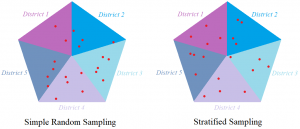

We show that the proposed method can affect the precision of mean and variance values.Why? Well, the report you reference is interesting, but it leaves open the question as to how $\operatorname)$ where $n$ is the sample size (the proof is in: Owen, 1997, Monte Carlo variance of scrambled net quadrature, SIAM Journal of Numerical Analysis 34:1884-1910). In other words, LHS can never be worse than IID sampling on a sample with one less point. Often, LHS is much better than this.

As in nutrition trials on dairy cattle, only a few cows may be available for financial reasons.Latin square design has following restrictions: Useful in animal nutrition studies. Laboratory trials with replication over time, such that the difference among experimental units conducted at the same time and among those conducted over time constitute the two known sources of variability.
If there are missing observations in the experiment then the analysis becomes complicated.The information in analysis of variance table does not identify the specific pairs or groups of varieties that differed. Despite of its great potential for controlling experimental error this design is not being used widely in agricultural experiments. Due to these restrictions the Latin square design is practically being used in experiments only where the number of treatments is not less than four and not greater than eight. In agricultural experiments where the land requirement is rigid then the actual layout in the field is laborious and approach to the central plots becomes difficult. On the other hand if the number of treatment is small, the degree of freedom associated with experimental error becomes too small for the error to be reliably estimated. The experiment becomes impractical if the number of treatment is very large because of large number of replications required.
For multiple comparison of treatments use LSD.test() function. To apply LSD test first load the library agricolae using library() function. Let’s apply Least Significance Difference test to see which variety outperformed regarding grain yield. To answer these questions you should go for mean comparison tests.Now let’s go deeper and see the performance of these varieties by applying suitable mean separation test.
If you type model(aov or lm) in y argument then the variable name for trt argument should be written in quotations else quotations are not requiredLibrary(agricolae) # LSD test LSD.test( y = model, trt = "Varieties", DFerror = model $df.residual, MSerror = deviance(model) /model $df.residual, alpha = 0.05, group = TRUE, console = TRUE) # Varieties, means and individual ( 95 %) CI# A 1.46375 0.2386900 4 1.2839503 1.64355 1.185 1.670# B 1.47125 0.2095382 4 1.2914503 1.65105 1.290 1.665# C 1.06750 0.4426153 4 0.8877003 1.24730 0.660 1.475# D 1.33875 0.1795538 4 1.1589503 1.51855 1.180 1.565# least Significant Difference: 0.2542752# Treatments with the same letter are not significantly different.# C 1.06750 b The results showed that varieties B, A and D were statistically at par and yielded more than variety C. Type the variable name in quotations while setting the value for trt argument.


 0 kommentar(er)
0 kommentar(er)
